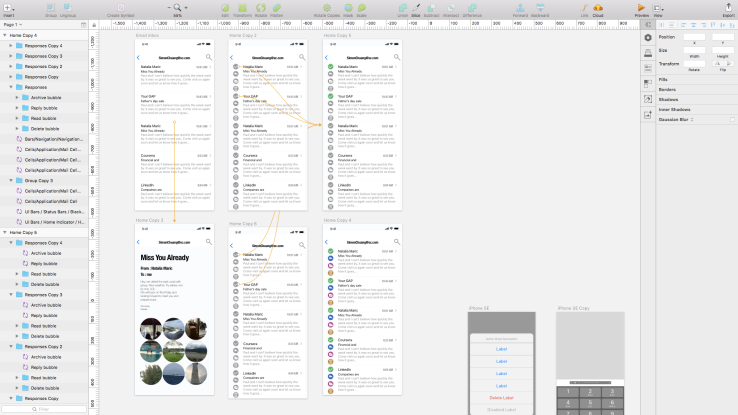Author: simonchuangblog
Apple Watch ring indications
Email app prototype
What if….
If I were the PL, I would ask writer to pay attention on the consistency of deliverables and prioritize it as the main rule to develop procedural content. Such as select the common term to describe the similar components, implement existed procedure/image and refer to previous generation content structure.
It’s because consistency increase the readability and trustworthiness. If user found many unique terms to indicate the same thing, they would get confused and failed to complete task or solve their problems. Take the air baffle as an example, this component is for guiding the air flow in the system thus cooling it within the desirable temperature. If the content name this baffle as guider or other term, user might think what type of this guider is because s/he never heard this name before. User also feel unfamiliar with this name and spend more time on clarify this term on their own.
Second, consistency reduce the develop cost and time. When we created a new term, we need to verify this term’s reliability with Acrolinx. It would take couple of weeks for terminology specialist to research and validate it. Besides, new term means that all relevant content need to be update. It certainly against the purpose of Knowledge Management and DITA style.
Third, inconsistency in content shows that the team is unable to communicate effectively. Discussion is the essential activity between teammates to make decision or improve the content. Although SMEs provided many suggestions and corrections during the review stages, understand those changes is more important than implementation. To know the reason of alter the term that we usually use and express our concern on consistency to SMEs. Explain our thoughts from the doc develop perspective and loop more teammates for discussion, such as from Marketing.
My first iPhone X mock-up

the art of 1/1 session
How ofter do you have a 1/1 session with your teammate? Weekly, monthly or quarterly? What topics have discussed? Did it wrap up in a conclusion and few action items? In my past experiences, me and my supervisor usually have our session bi-weekly. Before it, I would prepare my update on workload, what project fall into my plate and even the weather in both Taipei and San Diego. If there is no surprise, we closed the meeting within 10 to 15 mins. In the course of project management, talk to co-worker individually is inevitable and vital for project manager. It’s not only because some different ideas would be shared from different perspectives but also teammate feel more comfortable than open it up in group meeting.
Private discussion is not only restricted in the working environment. It could be held during the lunch break or just few mins in the elevator.
Project timeframe
At the initial stage, project manager decided the project scope that what should be included and other should be removed. Manager decide what deliverables should be provided in current technical documentation’s project, such as user guide, maintenance and service guide and labels which would stick with the product. Warnings and cautions are eliminated or integrated into the manual. This activity reflects how to allocate resource and thus pay attention on task completion. To achieve goals and supply projects in time, schedule the project’s time frame is also vital at the initial stage. Serval checkpoints are to measure achievement. Segmentations between checkpoints would keep project teammates on track. First, second or even third review stages are good examples for dividing main timeframe into small pieces. Activities, such as email confirmation with SMEs, attend engineering meeting and review option/spare component lists, are the corner store of every stage. These activities with sequence and thus need to complete first then continue till the end. Following steps would be derived from the predecessor or just capture information for the pervious activities. Assignments to teammates should be communicate and ensure everybody could and would complete before or within the deadline. If there is difficulties to finish assignment in time, teammate should seek out assistant or help, so manager would reschedule time line or rearrange tasks.
How we consume the metadata?
As the definition from Wiki, the metadata is the “data of data”. And how to utilize these info to understand user’s behavior and activities when using the application or software? Such query prom up during my researching on the particular software to understand what type of content my colleagues use or reuse frequently?! I’m wondering which terminology they search most? And what whose creation are cited the most?! Which topic has been derived the most
So, for the content management software, the metadata of the deliverable is description of content, such as the author, the date it created, total words, chapters and even the comma in this content. Would this be helpful for writer/project lead to expand based these numbers? Not really. But it would certainly assist someone conduct a search or research when digging the database. And I supposed that the search functionality is based on obtained metadata in this software.
Two types of metadata are within in the utilization of software. One is existing content’s metadata, such as user is looking into particular term in the repository. The other is when utilizing this software to construct content. The later one is more relevant to surveillance since administrator could easily identify user’s intention while browsing the software, their activities among subpages in the site and how long they stay within one page?
Example of the metadata from Microsoft Word.

Windows’ metadata

Create infographics manually or with internet-based application?
When attended the course of data visualization, instructor gives some apps that available to convert vast data into an interaction web page. As the beginner of the infographic design, I would prefer generate the graphic via the design software instead of those cloud-based apps. It’s not only because the “hand-made” graphic would be simple and easy to understand but also customized content and style are unique and informative. Most of the web-based apps are equipped with same elements and design. For example, the drag and drop (d&d) fundamentals in tableau are the same.
My thought for dating app to utilize the geographic-based application is to show location of app user. How far or close to the user itself and the others’ information, such as he/she likes to date a non-smoker, a pet lover or only into long-term relationship.
Also, this dating app could cooperate with local stores to offer deal, e.g. when two or more users are matched, message the nearest café or restaurant to both and invite each for a simple gathering. If both sides are willing to meeting and accept this arrangement, system would 
Wow, Microsoft has a tool for converting the data into a chart
Thanks Oreilly, I found a course is about Microsoft’s new application. Surprisingly, the functionality to convert the data to a chart which is leveraged from the existing software – Excel. Similar to the task in Adobe’s illustrator, opt the chart type and then drag and drop (d&d) the data sheet’s info into selected chart. It automatically transfer to the boxes or divided pie chart.
However, I’m not surprised that Microsoft offers this app’s certification. User who want to obtain this credit should attend an examination which check the familiarity and skill to utilize elements in Power BI. 












